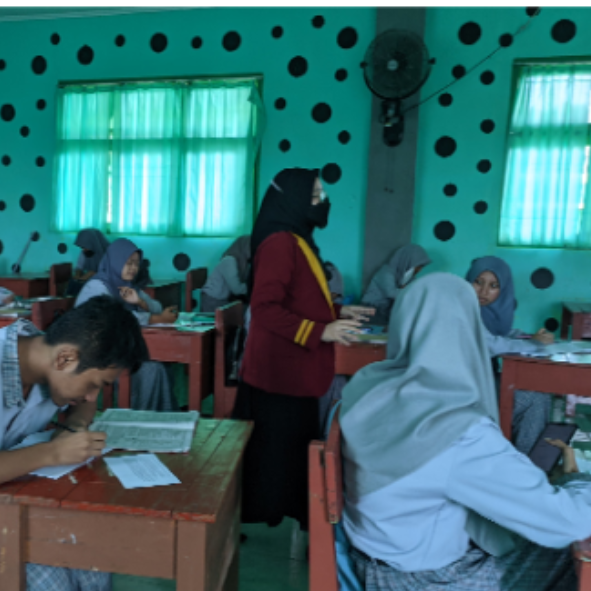Lexical and grammatical errors in Indonesian-English translated texts: A text analysis on Indonesian EFL students’ translation work
DOI:
https://doi.org/10.21070/jees.v8i1.1674Keywords:
error analysis, translation, EFL learnersAbstract
This current study aimed to find out lexical and grammatical errors in Indonesian to English translation texts made by Indonesian EFL learners in a private senior high school in Lampung. A qualitative case study design was adopted in this research. Documentation and literature review were used as the research instruments. To obtain the data, the researchers used 15 simple sentences and a short text in Indonesian. A total of 25 students participated as the sample in this research. The results suggested that there was a total of 402 errors made by the students and the students made more grammatical errors than lexical errors. Regardless of the discrepancy in students’ CEFR level, the most frequent errors found in students’ translations were omissions (97 items), confusion of sense relations (73 items), misformations (46 items), and distortions (40 items). After identifying the errors, the researchers also attempted to describe the possible sources of errors to fill the gap in previous studies. Based on the analysis, the possible factors influencing the errors were the transfer of phonological system, transfer of lexico-semantic errors, transfer of morphological elements, transfer of grammatical elements, transfer of stylistic and cultural elements in interlingual errors, and communication strategy-based errors and learning strategy-based errors in intralingual errors.
HIGHLIGHTS:
- Both intralingual and interlingual errors played essential roles in influencing students to commit errors when translating texts from Indonesian into English.
- The students committed more grammatical errors than lexical errors.
- It is evident that errors are rule-governed and systematic in nature, meaning that the errors committed by the students are not randomly produced but are systematic deviations of patterns in the input of language norms in which the learners have been exposed or have learned.
Downloads
References
Al-Halawani, A. (2018). Error analysis: A case study of Malaysian EFL learners. The European Proceedings of Social & Behavioural Sciences EpSBS, 94-101. https://doi:10.15405/epsbs.2018.05.99
Aminatun, D., Ngadiso, N., & Marmanto, S. (2018). Applying PLEASE strategy to teach writing skills to students with different linguistic intelligences. Teknosastik: Jurnal Bahasa dan Sastra, 16(1), 34-40. https://doi.org/10.33365/ts.v16i1.120
Ayu, M., Diem, C. D., & Vianty, M. (2017). Secondary school students’ English literacy: Use of interactive read aloud instructional strategy. International Journal of Applied Linguistics & English Literature, 6(7), 292-299. https://doi:10.7575/aiac.ijalel. v.6n.7p.292.
Brown, H. D. (2006). Principles of language learning and teaching (5th ed.). Pearson Education. https://smartlib.umri.ac.id/assets/uploads/files/af2ff- language-teaching-principles-1-.pdf
Creswell, J. W. (2013). Qualitative Inquiry & Research Design: Choosing among five approaches (2nd ed.). SAGE.https://revistapsicologia.org/public/formato/cuali2.pdf
Colina, S. (2018). Fundamentals of translation. Cambridge University Press. https://assets.cambridge.org/97811070/35393/frontmatter/ 9781107035393_frontmatter.pdf
Cúc, P. (2018). An analysis of translation errors: A case study of Vietnamese EFL students. International Journal of English Linguistics, 8(1), 22-29. https://doi:10.5539/ijel.v8n1p22
Dulay, H. C., Burt, M. K., & Kreshen, S. (1982). Language Two. Oxford University Press. https://repozytorium.ukw.edu.pl/bitstream/handle/item/2617/Majer%20H.%20Dulay%2C%20M.%20Burt%2C%20S.%20Krashen%20%20Language%20Two.%20Oxford%201982.pdf?sequence=1&isAllowed=y
Gulö, I., & Rahmawelly, T. V. (2018). An analysis of omission in students’ English writings. Teknosastik: Jurnal Bahasa dan Sastra, 16(2), 55-59. https://media.neliti.com/media/publications/300850- an-analysis-of-omission-in-students-engl-9ff39031.pdf
Gulö, I., & Setiawan, D. B., & Sari, L. (2022). Grammatical mistakes: What is the problem now?. Teknosastik: Jurnal Bahasa dan Sastra, 20(1), 51-56. https://doi.org/10.33365/ts.v20i1.1891
James, C. (2013). Errors in Language Learning and Use. Routledge Press. https://www.perlego.com/book/1557631/errors-in- language-learning-and-use-exploring-error-analysis-pdf
Kazakova, T. A. (2015). Strategies of literary translation. Journal of Siberian Federal University. Humanities & Social Sciences, 8(12), 2842 2847. https://doi:10.17516/1997-1370-2015-8-12-2842-2847
Keshavarz, M. H. (2012). Contrastive Analysis & Error Analysis. Rahnama Press.https://www.researchgate.net/publication/353466608_Sample_pages_of_Contrastive_Analysis_Error_Analysis_and_Interlanguage
Khanom, H. (2014). Error analysis in the writing tasks of higher secondary level students of Bangladesh. GSTF International Journal on Education (Jed), 2(1), 39-44. https://doi:10.7603/s40742-014-0002-x
Koman, H. N. N., Hartono, R., & Yuliasri, I. (2019). Translation errors in students’ Indonesian-English translation practice. English Education Journal, 9(2), 206-218. https://doi:10.15294/EEJ.V9I2.29372
Mandasari, B., & Wahyudin, A. Y. (2021). Flipped classroom learning model: Implementation and its impact on EFL learners’ satisfaction on grammar class. Ethical Lingua, 8(1), 150-158. https://ethicallingua.org/25409190/article/view/234
Nida, E. A. (1964). Toward a science of translating: With special reference to principles and procedures involved in bible translating. Brill. https://www.jstor.org/stable/25000397
Qodriani, L. U. (2019). English interference in Bahasa Indonesia [Indonesian language]: A phonology-to- orthography case in instagram caption. Proceedings of the 3rd English Language and Literature International Conference, 3, 349-355. https://jurnal.unimus.ac.id/index.php/ELLIC/article/vie w/4730
Richards, J. C., & Schmidt, R. (2010). Longman dictionary of language teaching and applied linguistics (4th ed.). Pearson Education Limited. http://www.saint- david.net/uploads/1/0/4/3/10434103/linguistic_term_di ctionary.pdf
Rido, A. (2020). English for university graduate employability: Students and employers’ voices. Proceedings of the Twelfth Conference on Applied Linguistics (CONAPLIN 2019), 430, 6-10. https://doi:10.2991/assehr.k.200406.002
Rido, A., Kuswoyo, H., & Ayu, R. (2020). Interaction management strategies in English literature lectures in esehatan university setting. Indonesian Journal of EFL and Linguistics, 5(2), 315-337. https://doi:10.21462/ijefl.v5i2.286
Robinson, D. (2012). Becoming a translator: An introduction to the theory and practice of translation (3rd ed.).Routledge.https://www.researchgate.net/publication/338881885_Becoming_a_Translator_An_Introduction_to_the_Theory_an d_Practice_of_Translation
Sari, B. N., & Gulö, I. (2019). Observing grammatical collocation in students’ writings. Teknosastik: Jurnal Bahasa dan Sastra, 17(2), 25-31. https://doi.org/10.33365/ts.v17i2.325
Sammut-Bonnici, T., & McGee, J. (2014). Case study. Wiley Encyclopedia of Management. https://doi:10.1002/9781118785317.weom120012
Simanjuntak, H. L. (2019). The translation of English passive voice into Indonesian. Teknosastik: Jurnal Bahasa dan Sastra, 17(1), 40-49. https://doi.org/10.33365/ts.v17i1.231
Thornbury, S. (1999). How to Teach Grammar. Pearson Education Limited. https://jonturnerhct.files.wordpress.com/2014/09/how-to- teach-grammar-scott-thornbury.pdf
Wongranu, P. (2017). Errors in translation made by English major students: A study on types and causes. Kasetsart Journal of Social Sciences, 38(2), 117-122. https://doi:10.1016/j.kjss.2016.11.003

Published
How to Cite
Issue
Section
License
Copyright (c) 2023 Salma Mu'min Shiddiq, Lulud Oktaviani, Sakhi Herwiana, Citra Suryanovika

This work is licensed under a Creative Commons Attribution 4.0 International License.







